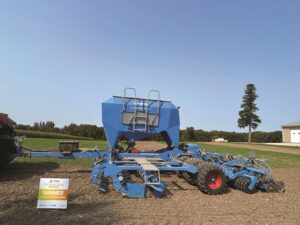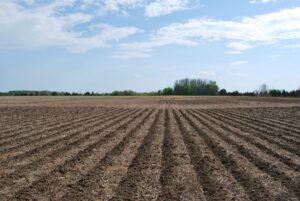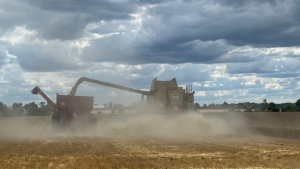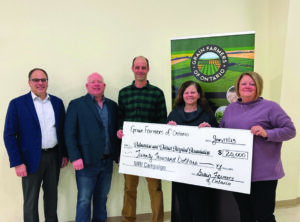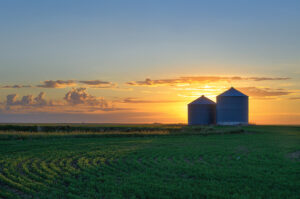Field Observations
SPRING 2025

June 19, 2025
As summer creeps closer, warm temperatures are on the rise. So far, crop heat unit (CHU) accumulation remains slightly behind the five-year average. However, with warm temperatures being experienced, crop stage progression is rapidly occurring.
Corn
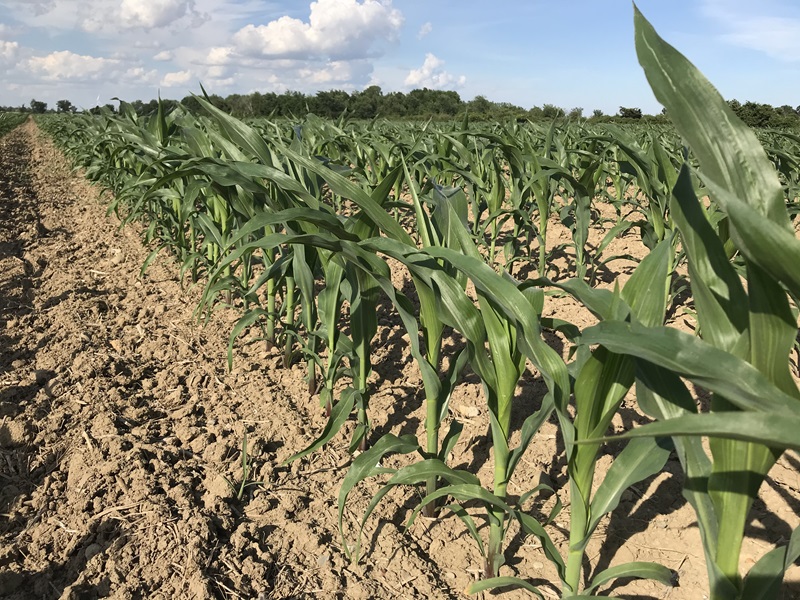
Overall, the corn crop is looking good with corn staging up to V7.
The growing point is out of the ground, and ear initiation is occurring currently. Any stress on the crop in the next two weeks will determine rows per ear and kernels per row, as this is determined by the V12 stage. Make sure your crop is well set up to be stress-free at this time.
Be sure to scout for weeds. The impact of not getting rain and having weed escapes is active ingredient-specific. Keep an eye on weed populations. Check for patterns in the field – did the sprayer miss, or are you seeing resistant weeds? If a rescue treatment is applied, be sure to use a different active ingredient than the first pass. Some farmers may use glyphosate at a 2X rate, if the sprayer has overlap, those plants are now getting a 4X rate, and flashing can occur, which is when yellowing and chlorosis in the whorl is seen along with crinkled leaf edges. Surfactant burn can also occur, which can cause some damage, at a higher rate of application in overlaps. There are many fields with a lot of weeds in them. Remember the critical weed-free period in corn, it is V1 to V6 (1 to 6 leaf collars). Keep the field clean early.
Tracey Baute, Ontario Ministry of Agriculture, Food and Agribusiness (OMAFA) field crop entomologist, is looking for corn rootworm trap participants in Ontario. Those with continuous corn and with a history of repeated use of Bt-CRW hybrids are encouraged to participate, but fields that were corn last year and may be in other crops this year can also be scouted for emerging beetle populations. If you are interested in participating in the network and need traps and protocols, please contact Baute (tracey.baute@ontario.ca) so traps can be sent out before trapping starts at corn pollination timing.
Soybeans
Soybean planting is at 95 to 100 per cent complete. Areas that are still working on planting are those with clay soils, and some areas are putting in soybeans after a first cut of hay comes off. Soybeans have really been progressing, staging up to the third trifoliate. Expect to see some flowers next week as buds are forming on the most advanced plants.
Soybeans are photoperiod sensitive. It is a truly amazing phenomenon that ensures that flowering occurs at the ideal time of year. Soybeans are a short-day plant, meaning that flowering initiates by the lengthening of darkness. So, after the summer solstice, as days start to get shorter and nights longer, soybeans will begin to flower. Under ideal conditions, early-planted crops may begin flowering before the solstice, with flowering ramping up once days begin to get shorter. One note, though, is that early maturing varieties are less photoperiod sensitive than later maturing varieties.
Keep an eye out for yellow soybeans in fields this time of the year. Yellowing could be due to a number of reasons: herbicide burn, soybean cyst nematode, soil conditions being dry, the soybeans may be transitioning to nitrogen fixation, Mn deficiency (if you see this, apply Mn as soon as possible). Be sure to scout and see if there are patterns, on top of knoll hills, etc., to help determine the cause.
Around this time, soybeans should begin nodulating (five to six weeks after planting). It is always a good idea to see how nodulation is developing. Rhizobia in the soil infect the root and produce nodules on the plant where they fix nitrogen gas from the atmosphere, turning it into a more usable form of nitrogen for the plant. In first-time soybean fields, nodules will be found on the tap root; in fields that have had soybeans before, the nodules will be on the lateral roots. They should begin active nitrogen fixation around V2 to V3. The nodules should be quite large (two to four millimetres), and eight to 10 should be found per plant prior to flowering. If there are fewer, sample again in a week. Nodules that are actively working should be pinkish inside. If the nodules are small and whitish, they have not begun fixing nitrogen yet. Poor nodulation can be due to several factors, such as low soil pH, compacted soils, flooding, droughts, temperature extremes (ideal temperature for nodule formation and nitrogen fixation is around 25 to 30 °C), plant stress, high soil residual nitrogen, and/or low quality of inoculants.
Some challenges have been heard of in fields that were sprayed with a herbicide during or right after the cold weather, which occurred a couple of weeks ago. During the cold, plants are not actively taking up herbicide, as the plant’s metabolism slows right down. If there is low plant biological activity, there will be reduced herbicide activity. Remember the critical weed-free period in soybeans is V1 to V3 stage (1st to 3rd trifoliate). Keep it clean early.
As soybean post-emergent spraying ramps up, be sure to follow proper mixing orders for herbicides and ensure that the correct herbicide is going on the correct field.
Cereals

Spring cereals are tillering.
Winter wheat is staging from the flowering (GS 60 to 69) to milk (70 to 77) to dough stage (GS 80 and upwards towards ripening) depending on the region of the province. Some fun facts about the milk stage: at the milk stage, flowering is complete, and the kernels begin to accumulate starch and protein. The kernel size increases but does not yet accumulate dry matter. Challenging weather conditions (too hot) during the milk phase can affect future dry matter accumulation and potentially decrease yield. The longer the conditions last and the earlier in the grain fill period that they occur, the greater the impact on yield. So, preferably through the flowering, milk and early dough stages, moderate temperatures are ideal for grain fill.
Keep an eye out for cereal leaf beetles (CLB) as they are often spotted in winter wheat fields around this time, with spraying sometimes required. The spraying window is closing as the pre-harvest interval nears. Always be sure to read and follow the label instructions. After CLB in winter wheat, it will move to spring cereals, so be sure to scout fields accordingly. If identifying CLB in winter wheat, one CLB adult or larvae per stem is the guideline for control after boot but prior to heading. If lots of feeding is found on the flag leaf in early heading, control may be needed if they are feeding actively. If finding CLB in spring cereals, the threshold is an average of three larvae per tiller before the boot stage. View Page 345 of the Agronomy Guide to Field Crops for more info.
Let’s Talk Slugs Webinar recording
Hosted by the Ontario Soil Network, the webinar features entomologist Dr. John Tooker (Penn State) and Tracey Baute (OMAFA) in conversation with farmers across Ontario and beyond, diving into:
- Why slugs have been on the rise
- What we’ve learned from recent seasons in Ontario and Pennsylvania
- How planting dates, cover crops, and insecticide use affect pressure
- What predator support and scouting can really do
Grain Farmers of Ontario supports the Ontario Soil Network.
June 12, 2025
Soybean planting is still ongoing, while corn planting has almost wrapped up. Recent warm weather has helped with crop emergence and growth. Be on the lookout for weeds, disease and insect pests.
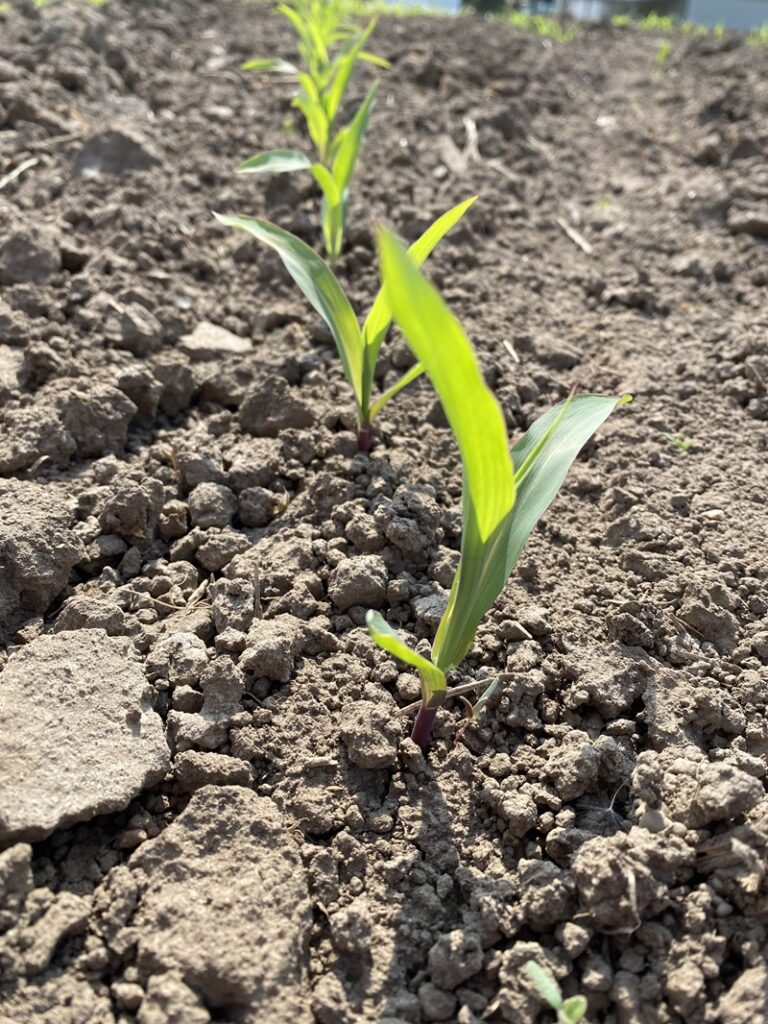
Corn
Planting for corn is wrapping up, with 95 to 100 percent complete. Areas with livestock relying on corn for feed are the areas still aiming to plant. Corn is staging from V1 to V5. For information identifying corn stages, see here.
Join Tuesday Kristianson, University of Guelph MSc student, in this GrainTalk Webinar about corn rootworm management strategies and innovative research.
Corn rootworm trap participants are wanted. More information can be found here. Grain Farmers of Ontario helps purchase traps for this project.
Scouting fields for weeds is crucial around this time due to the critical weed free period in corn being from V1 to V6 (one to six leaf collars). Be sure to read and follow labels for any pesticide applications.
Soybeans
Soybean planting is 85 to 98 percent complete, with many hoping to wrap up planting by the end of this week, if weather permits. With the warm weather last week and into this week, soybean growth really took off, staging from emergence to the 2nd trifoliate. Narrow row fields will be filling in fast over the next week or two.

Be sure to get out and scout fields; weeds are certainly emerging, and it is important to make sure that pre-emergent herbicides are working. Remember the critical weed-free period in soybeans is V1 to V3 stage (1st to 3rd trifoliate). Plants can detect changes in their environment, such as weed competition, and integrate that information into their growth patterns. Growth patterns change in plants when they are near weeds, due to the response to aboveground signals of light quality (red: far red light effects). Red:far red light effects have been seen to cause plants to develop fewer roots (lower root biomass) and have higher shoot to root ratios than plants without competition of weeds. In some cases, soybean seedling root biomass can be decreased by as much as 36 percent due to neighbouring weeds.
Soybeans should begin nodulating two to three weeks after emergence. It is always a good idea to see how nodulation is going. In first time soybean fields, nodules will be found on the tap root, in fields that have had soybeans before, the nodules will be on the lateral roots If you want to learn more behind the science of nodulation read more here.
Keep an eye out for aphids, as they sometimes begin to appear in early planted fields around this time of the year. For more on what to look for this early in the season, read here. The Aphid Advisor app is a great resource that Grain Farmers of Ontario helped support through research.
Cereals
Wheat in southwestern Ontario has hit the grain fill period. In other regions of Ontario, it is moving very quickly into heading and flowering. Do not miss the T3 timing; be sure to get out and scout for optimal timing. T3 sprays will protect against fusarium and rust if varieties are prone to these diseases and if conditions are favourable.
Grain fill begins after pollination (Z70), and it takes about 660 growing degree days (GDD) for the grain to fill. The warmer the days, the faster the accumulation of GDD. And the shorter the grain fill period, the less potential there is for yield. It would be nice if the grain fill period would see some rain along with temperatures being a little cooler, to extend the grain fill period.
Aphids in winter wheat have been found. More information can be found here, via the Crop Protection Network that Grain Farmers of Ontario supports. Overall, the threshold for cereal aphids is 12 to 15 per stem prior to heading, and an insecticide is recommended. Once the head is present, 50 or more aphids per head would require control. Beneficial insects can certainly help manage aphids, so be sure to monitor and make considerations with natural enemy populations in mind. It can be expected that cereal aphids will move to spring cereals. More can be found here.
Wheat Streak Mosaic Virus is also being identified in fields. More can be found here.
If fields have a very lush canopy, you may have spotted powdery mildew in the springtime. It is still present in the field and is moving up the canopy. This disease likes lots of humidity and moisture; however, heavy rain can wash it off. Take a walk and see how the wheat crop looks for disease.
Some rust has been found in wheat; it can be varietal specific. Many varieties have good resistance genetics, but take a look and see if your wheat variety is one of the more susceptible varieties. Stripe rust moves very quickly in field compared to common leaf rust.
Upcoming harvest
As we look towards wheat harvest, if grain trailers, gravity wagons, and/or grain carts were used to move treated seed, be sure to clean them out well. Contaminants in harvested grain can be cause for rejection of the load. More on cleaning out to avoid contamination can be found here.
Manage Resistance Now
Find strategies for managing resistance for weeds, disease and pests, and more here.
June 5, 2025
With the turn of the calendar to June, warm weather has followed. Crops continue to emerge and grow. Corn planting is getting closer to completion, while soybean planting is still occurring. Stay on the lookout for diseases, weeds and pests.
Corn
Corn planting progress is nearing the finish line, with 95 to 100 percent completed. Corn is staging from emergence to V4 (4 leaf collars visible).
Currently, early planted corn is undergoing a crucial stage. Until now, corn has been developing the seminal roots, and now it is time for the nodal roots to establish, roughly around V2 to V6 (2 to 6 leaf collars visible). By around V2, the first set of nodal roots should be visible, as each new leaf collar emerges, so will a set of nodal roots. Seedlings use nutrition from the seed reserves up until the V3 stage, when they begin gathering nutrition from the nodal roots. If the nodal roots are damaged or stressed, it can delay the corn’s development, due to the plant needing to rely on seed reserves as opposed to uptaking nutrients through the nodal roots. Things that might cause stress to the young corn plant’s nodal root development are salt injury from fertilizer, herbicide injury, seedling disease, insect feeding, compaction, and very wet or dry soils. Nodal roots will tap into the starter fertilizer band and use that nutrition for optimum development.
Some might notice some purpling of corn plants in fields at this time. As with most things, there is an environment by genetic interaction, meaning some corn hybrid genetics will show more purple than others. This is due to the genes in some corn hybrids for producing anthocyanin pigments. Under early season stress conditions and poor root growth, like our recent cold snap/frost with sunny days, the plant builds and expresses the purple (anthocyanin) pigments. Purple corn can also be caused by phosphorus deficiencies from restricted root growth due to soil compaction, like sidewall compaction in the seed trench from planting in wetter soils. Corn usually will grow out of the purple state if it has enough available soil phosphate, once the weather warms up and growth resumes. Typically, no yield loss will be seen, if nutrients have been applied at proper levels.
As the month of June progresses, it will be time for conversations about switching from longer-season hybrids to shorter-season varieties. And in some cases, fields that were slated for corn have been pivoted to plant soybeans, especially if the field is not drying up.

Soybeans
Soybean planting progress is 70 to 90 per cent complete. Soybeans are staging from emergence (VE) to unrolled unifoliate leaves (VC).
Some replanting decisions are being made. See past e news articles for more information on replant decisions.
Be sure to scout crops and look for weed escapes, particularly waterhemp and Palmer amaranth.
Cereals
Winter wheat is steadily progressing across the province, staging up to GS 69 (flowering complete). In southwestern Ontario, much of the wheat is fully headed out, and T3 fungicide applications have occurred over the past week or will be occurring once the field is at the right stage. A good reminder, make sure the sprayer is well cleaned out, as wheat is very sensitive at the flowering stage.
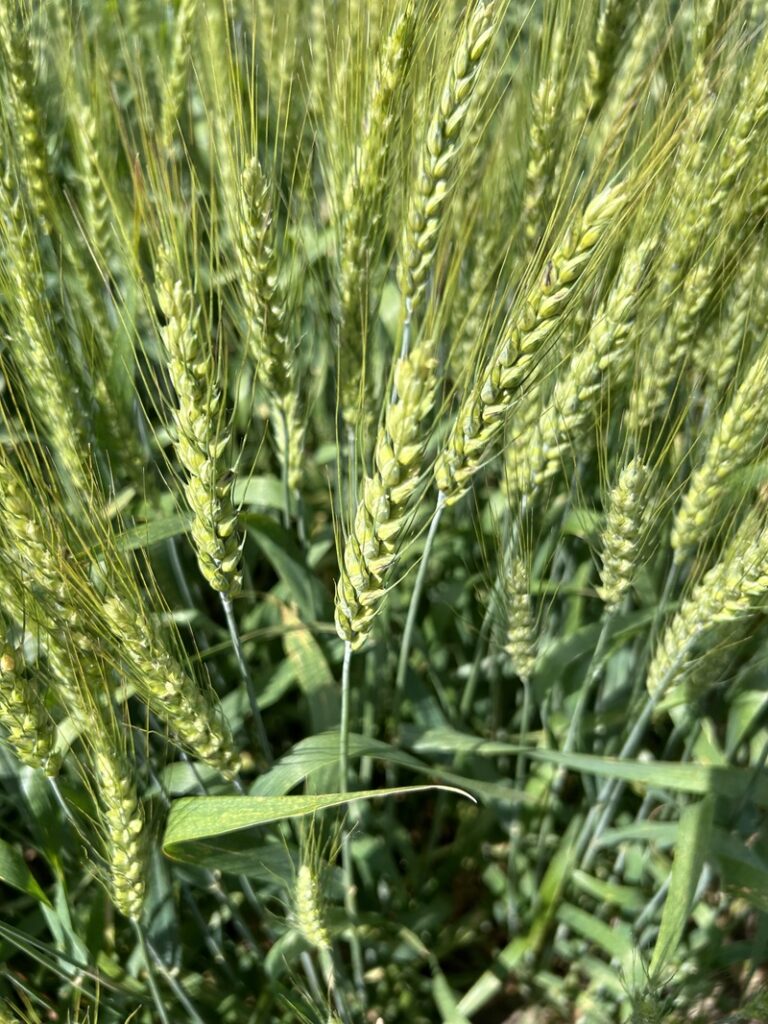
Unsure or not confident in wheat staging? View the Visual Guide to Winter wheat staging for in-depth cereal growth stages, wheat anatomy, key yield components and more.
Be sure to scout wheat to see if and how badly leaf rust and/or stripe rust are impacting wheat fields. Rust is being found in more fields than originally thought. Stripe rust, especially, can be a major yield robber. Best management is through variety selection, scouting and timely fungicide applications. Pay particular attention to which fungicide is being applied and the stage of wheat at application, as not all can be applied as heading approaches- always read and follow labels. If needing to view variety susceptibility, visit GoCrops.ca and view trial data by the Ontario Cereal Crop Committee. The lower the score, the higher the resistance. When scouting rust-infected fields, it is imperative to clean boots and clothing between fields to avoid disease spread.
Powdery mildew is still being identified. Discuss potential action if required with your agronomist.
Best practices to reduce spray drift
Join Dr. Jason Deveau as he shares insights on off-target pesticide movement, strategies to limit movement, and more in this Grain Farmers of Ontario GrainTalk Webinar and visit https://bedriftaware.ca/ for more information on reducing spray drift. Also, some tips for preventing and responding to off-target movement.
Agricorp Spring Planting Deadlines
Spring planting deadlines have passed or are coming up, depending on the region in Ontario. The planting deadline is the last day a crop can be planted to qualify for production insurance. Find out more here.
Mental Health
If you are struggling with feeling overwhelmed with decisions, or other challenges that farmers have throughout the season and want to speak with someone, there are many resources available.
Keep it clean
Your on-farm decisions play a key role in keeping markets open. Before you spray, Keep it Clean reminds growers, applicators, and crop advisers to always read and follow the crop protection label for application. Always follow the correct application rate. Apply crop protection products only at the recommended crop stage. Stick to the product’s pre-harvest interval – the number of days between spraying and harvesting the crop.
Reminder: Spray drones are not currently permitted for field crop applications of pesticides in Canada.
Learn more here.
May 29, 2025
Winter wheat is edging towards a T3 fungicide application if it is not already there. Pay particular attention to crop staging for optimum efficacy. Corn and soybean planting is still progressing.
Corn

Planting progress across the province ranges from 80 to 95 per cent complete. In some areas, particularly on clay soils, there is a challenge in finding a suitable window of opportunity to plant. Corn emergence has gone relatively well this spring. Corn is staging from emerged to V3 (a plant with three leaf collars), also known as the 4-5 leaf stage if you are counting leaf tips. Those that are side-dressing nitrogen are preparing to apply their side-dress if little to no starter nitrogen (N) was used. As the crop is growing quickly, we do not want to allow the plant to develop a nitrogen deficiency too early in the season. The growing point of the corn will be emerging at V4 -V5, so 164 to 246 growing degree days (GDD), which will be eight to 10 days away.
With a distinct three to four planting windows, corn has gone into great planting conditions. However, some poor emergence has been observed, which could be caused by several factors at planting time, including planter setup. With variable soil conditions, down-pressure settings, seed depth, closing wheel pressure, and the type of closing wheels combined with cold air and soils, some uneven emergence occurred. Sometimes, a guess at the weather is required, and adjustments need to be made to the planter for future conditions.
Last week, Grain Farmers of Ontario hosted a staff plant competition. The discussion highlighted growing plants from seed and the challenges involved in establishing a plant. A main topic of discussion that many have noticed is that this spring has been on the cooler side, and with that, planted seeds have sat in the cold ground for long periods of time, making them prone to insect damage. With cooler weather, soil-borne insects are often found in the top profile of the soil, and when it is warmer, they move down deeper into the soil, where seeds are not located. Evaluate corn stands and make decisions based on the economics of the current stand and the yield potential of a later planted crop. For CHU comparisons for Elora from May 1 to May 25, the 5-year average is 439; this year it is 290.1.
Sometimes, with cool springs, purple corn is prevalent. Low temperatures can trigger the accumulation of a pigment that causes purple-coloured leaves. Corn will grow out of this as warm weather becomes more common.
Also being identified this year is pale-coloured corn. With cool, overcast days and wet conditions being experienced, this would indicate reduced root growth and a lack of chlorophyll in the corn plant. The plant is still relying on seed kernel reserves for energy, and without sunlight, photosynthesis is reduced, and chlorophyll is limited. It may not necessarily indicate a nitrogen deficiency at this early stage, but sunnier conditions will drive the photosynthesis process, produce energy and increase the green colour of the plant while root development continues and transfers needed nutrients to the plant cells.
When considering herbicide applications on stressed corn, remember that corn plants need to metabolize the herbicide that is sprayed on them. Pale-stressed corn with a thinner leaf cuticle could absorb more herbicide and, due to stress, have a harder time metabolizing the herbicide, resulting in more crop injury. It might be a good idea to hold off on herbicide treatments until the corn is actively growing and has greened up a bit in order to limit more stress. However, and this is a HUGE consideration, the longer the herbicide application is delayed, the more yield loss to the crop as weeds get larger. Ideally, manage spraying on a field-by-field basis and aim for a product that has good crop safety. With the coming few days showing temperatures creeping upwards, it will certainly help relieve stress on the corn crop.
As May edges into June in the shorter growing season areas of the province, conversations for a hybrid switch from full season to shorter season may occur. For further information, visit Field Crop News.

Soybeans
Planting is roughly 60 to 75 percent complete. Soybean fields are now starting to see emergence as there has been some warmer weather.
Keep an eye on soybean stands; with the cool conditions around planting, emergence will be delayed, allowing for increased insect feeding and potential crusting issues from heavy rains.
The chart below can help guide the calculation of the final stand count and potential yield.
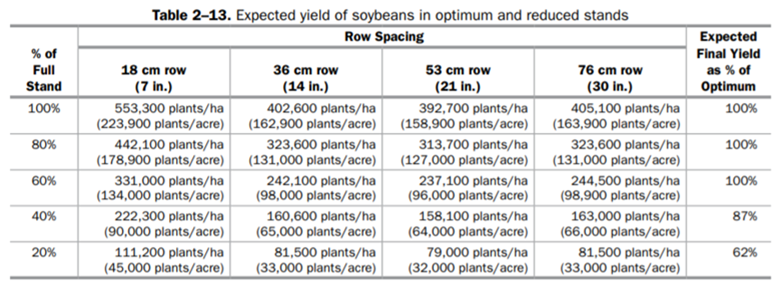
Keep an eye out for insect feeding damage on soybeans as soybeans are slightly more susceptible than corn for feeding damage.
Cereals
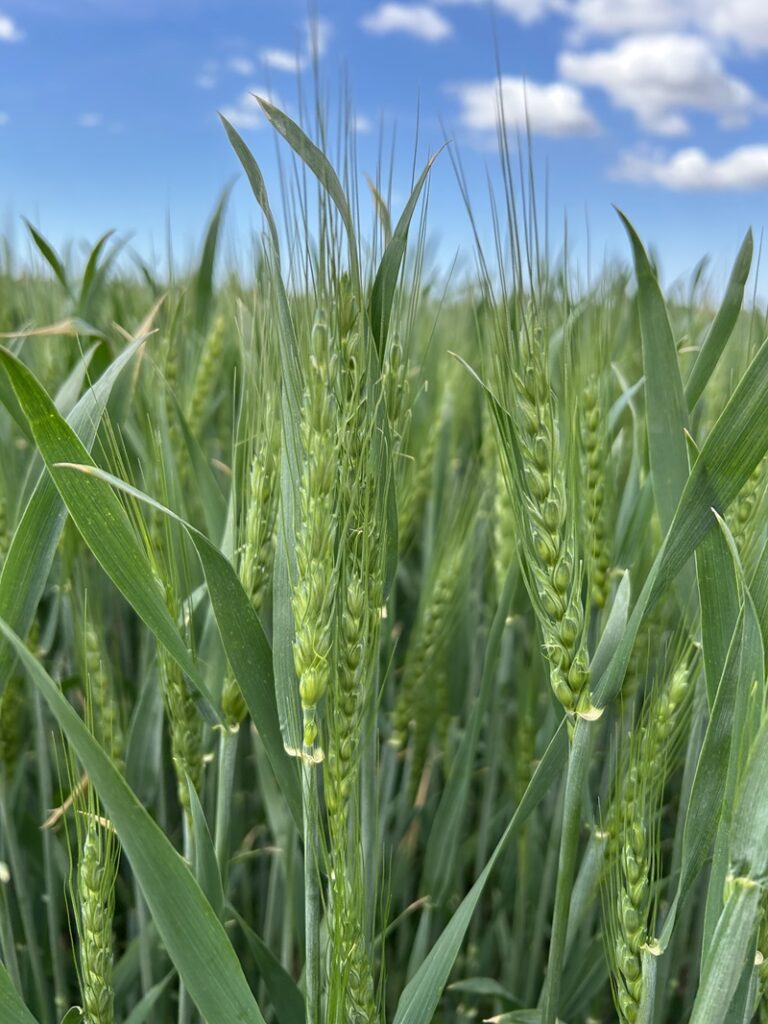
Spring cereals are staging from emergence to seedling growth.
Winter wheat is staging up to GS 61(beginning of flowering). T3 fungicide applications will be occurring soon to protect the wheat head from Fusarium infection. With recent heavy rains, it may pose a challenge in some areas for getting a timely T3 application without getting stuck or rutting up the field too much. The main indicator for T3 timing is when 75 per cent of heads on the main stem have emerged (GS 59), this is Day 0, optimum timing is Day 2. This is the beginning of pollination when anthers are visible on the middle of the wheat head. A good reminder is to make sure the sprayer is well cleaned out, as wheat is very sensitive at the flowering stage.

If no rain occurs during anthesis and early grain fill, the chance of DON is lower. With no rain during grain fill, kernel grain fill will also be limited. Ideal conditions for fusarium development is precipitation or high humidity for at least 12 hours for spore germination and infection. Temperatures favouring infection range from 16° C to 30° C, with the optimum range for F. graminearum being 25° C to 28° C. Which at least for some areas of the province these conditions have been experienced or will be in the coming days (if the weather app is correct).
May 15, 2025
Frost, emerging crops, pests and disease. A cool, wet few days with lots to be looking for in the fields.
Corn
Planting progress for corn is 75 to 95 percent complete. With many corn acres now in the ground and plants emerging, it is time to evaluate corn emergence. In some areas, there has been irregular emergence with the early planted crop. Corn planted in cool soils, or soils that drop below 10oC after planting, can struggle and take longer to emerge. Poor seedling vigour or insect feeding can take population levels down. It is a good idea to evaluate emergence now and find out if it was insect, seed, or operator error. If planted during a warm week with maximum CHU accumulation (30 per day) the corn could be out of the ground in five to six days, giving a lot less time for insects to be active. Soil temperatures would also move insects down into the soil profile, limiting impact and damage. It is not time that gets the crop out of the ground, it is the heat that drives the enzymatic process to get the seed to germinate, and with continued heat, helps the cells grow and develop into a seedling.
For best corn yields, we have been told from the U.S. corn specialists that if the crop emerges uniformly within a 12 growing degree day (GDD) (~20 crop heat unit (CHU)) window, this allows for a maximum yield potential at emergence and the perfect “picket fence”. A great way to evaluate emergence timing is to use the flag method – planting flags beside the plants as they emerge within an area of the field. Start by measuring 1/1,000 of an acre. On the first day that corn spikes through the ground, place a small flag beside all the emerged plants. Come back in 20 CHUs (this could be everyday depending on the CHU accumulations) and place a different colour flag beside the newly emerged spike for that day. Keep doing this until all the corn has emerged. Be sure to use a different colour flag on different days (or label each flag with emergence date). Complete the flag test on each row of the planter. If poorer emergence or delayed emergence is found on a particular row, it may be related to planter set up issues. This test is also great to evaluate different settings on the planter (deeper or shallower) or different attachments. Visually the row emergence may look the same, but once it is more visual with labeled flags, much can be learnt. Once all plants have emerged, aim to do a population count, in the designated area.
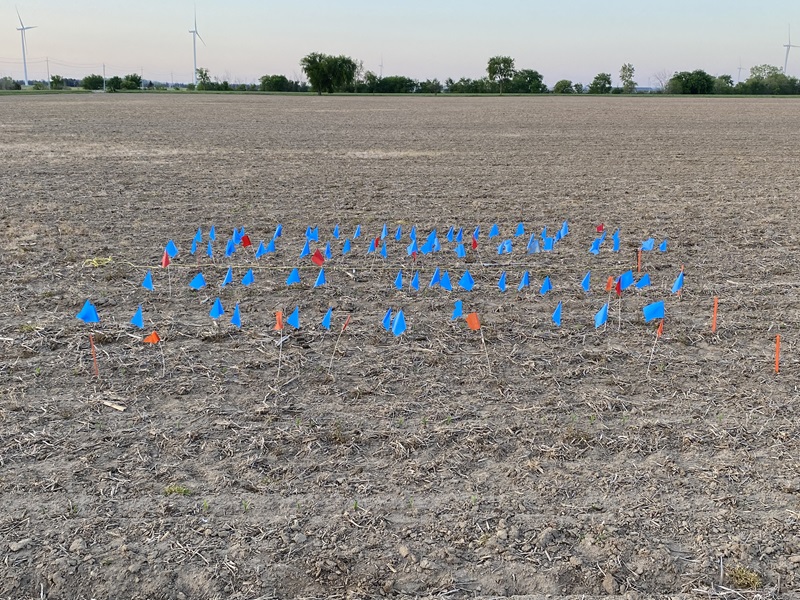
For more information on stand counts and replant decisions view this Field Crop News article.
As the season progresses, pay particular attention to the flagged corn plot. See if the later emerged plants are weaker and smaller. Did they pollinate later? How was the ear size or cob fill? Does emergence timing make a difference on your crop?
Earlier this week, areas of the province experienced cold nights and frost. At this point of the season, for corn at least, frost is not much of a concern. The growing point of the corn is still below the ground and will remain there for a few more weeks. If corn has been damaged by frost it is the exposed plant tissue that is damaged, at this point in the season. New plant tissue will continue to grow from the growing point beneath the soil surface.
Soybeans
Soybean planting progress is 45 to 60 percent complete provincewide. With early planted soybeans in the VE stage (emergence).
As soybeans continue to emerge, pay attention to the stand. Overall, soybeans are more prone to poor stand establishment than corn or cereals as the developing plant must push the cotyledons through the soil to emerge. If the soil has crusted over, the seeds will be challenged to push through the crust. Rains will likely help to soften the crust.
As with corn fields, frost was present on some soybean fields in low lying areas. Luckily not many soybean fields have emerged yet and there was good soil moisture conditions (which has been shown to help mitigate frost damage). Drought conditions, wind, and fast temperature swings seem to be major culprits for increased frost damage. However, emerged soybeans have an exposed growing point. Soybeans can tolerate some cold temperatures, but it depends a lot on the duration of the freezing temperatures. Parts of cotyledons may turn brown/black and the unifoliate may be damaged, but the growing point can still be spared. Watch for new growth in the coming days. If the stem below the cotyledons is damaged, the plant will not survive.
Cereals
Most spring cereal planting is wrapped up (or close to) with spring cereals emerging.

Winter wheat is staging from first node detectable (GS31) up to the boot stage (GS45 boot just visibly swollen) with heading soon around the corner for some in the south.
Keep an eye out on wheat fields that are showing fertilizer burn from applications around the cold weather. If the flag leaf was not out at time of application, the damage would only be visible on the older leaf tissue and will cause little to no yield loss. Overall, across most of the province, there has been ample moisture to help ensure good growing conditions.
But with good moisture also comes increased disease risks. See last week’s comments for more on diseases to be on the look out for.
Ceral Leaf Beetle have been spotted at low levels. Scout fields with a known history of the pest first and aim to continue scouting known fields and others for the next few weeks. More info on scouting here.
Sulphur deficiencies are still being seen in winter wheat. More on S deficiencies here.
Be Drift Aware
Are you drift aware? Anytime that spraying occurs there is a potential for drift. Learn more about how to reduce drift here.
May 15, 2025
Rapid planting over the past several days allowed for lots of acres to be planted in a short timeframe. Corn planting is coming to a close in some areas, while other regions are still working away, and similarly for soybeans.
Corn
Corn planting progress is 60 to 80 percent, with earlier-planted corn now emerging (VE).
Pay close attention if a pre-emerge herbicide was planned, that corn has not emerged at the time of spraying. Dig for the seed to see how far the coleoptile is from the surface. If plants are emerging, make sure the herbicide program allows for application on emerged plants – some do, some do not.
Black cutworm moths have been caught in traps in Ontario. For more information on Black cutworm and the threat they may pose, view this article. There may be some leaf feeding already on tissue by larvae.
Soybeans
Soybean planting has begun in earnest over the past week, with planting progress ranging from 15 to 30 percent. As with corn, there has been a wide window of planting opportunity in most areas with fit, warm soils.

Soybeans that were planted at the end of April are just beginning to emerge (VE). Emergence, depending on soil conditions, planting depth and temperature, can range from five to 21 days (less is better). From VE to VC (cotyledons emerged) takes roughly five days.
The increase in daytime and nighttime temperatures will drive crop heat unit (CHU) accumulation, resulting in rapid plant growth (both weeds and crops). Burndown herbicide applications will now see faster-acting herbicidal activity as plants develop quicker as temperatures rise. Some weeds, such as winter annuals, have continued to grow during the past few cooler weeks. Canada fleabane has already progressed and is ready to bolt with these warmer temperatures. Be timely with a burndown, as bigger weeds are harder to control and may need some additional measures to have effective control. Overall, small, actively growing weeds are easier to control. For practical tips on herbicide application, read this Ontario Grain Farmer article.
Cereals
Spring cereals have emerged in some areas. Northern regions have begun planting as soils have become fit.
Winter wheat in Ontario is around the second node (GS32) up to flag leaf emergence (GS37, flag leaf just visible). Wheat has moved quite slowly this past month, with cooler temperatures at night but also during the day. Some areas even experienced a mild frost within the last week. However, no damage to any crops was reported.
Stripe rust and leaf rust in winter wheat have been identified in Ontario earlier this week. Both rust strains can be concerning as they can rob significant yields if present and not managed. Varieties that are susceptible should be prioritized for scouting; however, all fields should be monitored. Susceptibility ratings can be found at GoCrops.ca. Rust can blow in from the south on storm fronts and, in some instances (as with this recent stripe identification), can overwinter in Ontario if conditions are present. Powdery mildew is still also a concern as well in some fields- be sure to scout and address the concern as needed.
T2 fungicide applications can occur from flag leaf emergence to prior to the head emerging (GS 39 to 41 in order to protect the flag leaf from disease. Always read and follow the labels of fungicides, taking special note of each fungicide and their application window, as they are not all the same. It is also important to note that a herbicide should not be applied after the flag leaf has emerged, or crop damage can occur to the flag leaf or developing wheat head.
Keep an eye out for pests in the field, particularly the cereal leaf beetle, which can often be found around this time of the year. Army worm moths are also being found; so far, counts are on the lower side (this can change quickly); stay tuned if the larvae become an issue. The Pest Manager App is a wonderful source of information on all pests. It can be downloaded here. Grain Farmers of Ontario supports much of the research that is used in the app. It is applicable for pests, weeds, and diseases and is updated regularly based on current research data.
Farm Safety
As with all busy periods of the year, keep farm safety at the top of mind, taking breaks when needed so that mistakes are not made.
This week is Kids FarmSafe Week, a week to help raise awareness about the importance of farm safety on the farm through the Canadian Agricultural Safety Association. It is our job, as parents and farmers, to keep kids safe. My #1 rule for our kids on the farm- if the equipment is running (moving or not) and they aren’t with an adult, then they MUST stand by something larger than themselves (a tree, a building, etc.). The operator will see the tree but won’t always see the kid.
This is what kept me safe when I was a child, and I pray it helps keep my kids safe, too.
May 8, 2025
Overall, there was a tremendous amount of progress over the past two weeks for spring planting, with spring cereals, corn, and soybeans all hitting the soil within days of each other, all within an early planting window. However, rains moved across the province, slowing planting progress.
Corn
A large number of acres have been planted early this spring, with roughly five to 70 percent planted depending on the region. There has been less planting in areas that were busy spreading manure, planting spring cereals, or waiting for ground conditions to dry and warm up. There are still many acres to go, and patience is still key. In the middle of May 2020, we saw the ground get quite hard after planting, as heavy rains and snowfall chilled the seed and firmed the soil around the seed. As of now, we have not had that hard, pounding rain that causes the soil to become compacted, but the month of May is not foreign to cool temperatures, frost, and snow in some years.
Corn typically takes 180 crop heat units (CHU) before emergence, depending on planting depth. For seed that was planted at the end of April, they have received 65 crop heat units (CHUs), in Ridgetown (slightly below the 13-year average), with Elora at 36 CHU, also below the 55-year average, as of Tuesday, May 6, based on the previous 7 days. In Northern Ontario, corn is just beginning to be planted.
Soybeans
As thoughts turn to planting soybeans, be sure to take careful note of soybean varieties and the traits that are being planted, so there are no mistakes or confusion with the sprayer.
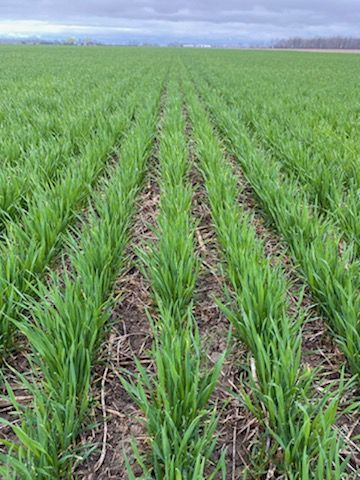
Cereals
Currently, winter wheat fields across the province are GS 31 (first node detectable) to GS 37 (flag leaf just visible). T2 fungicide application is approaching (GS 39- flag leaf collar visible) in early-planted fields in the more southern areas of the province. Herbicide applications need to cease by flag leaf, as not to cause head injury.
With wet weather that has been experienced the past few days be on the look out for wheat diseases; powdery mildew and septoria are two that can be common, especially in susceptible varieties. Be sure to monitor and take action with a fungicide, if warranted.
As of yet, stripe rust has not been reported in the province, but based on cool wet weather and storms, keep an eye on disease developments.
Spring cereals are still being planted in some areas and are just about to emerge in others. Warmer weather will help with emergence.
Weeds
It is time to get out and scout fields for weed pressure- the smaller the weed, the easier it is to control. Read more about herbicide-resistant weeds found in 2024, and be aware of what populations are found locally.
If you are trying to identify weeds or send pictures of plants for recommendations or guidance, taking a quality photo really helps. Doug Young at the University of Guelph Ridgetown Campus created a short video on the best ways to photograph weeds and crops.
Bluegrass has been a concern in winter wheat for being a yield robber and hard to control. Learn more about this weed here.
Agricorp
May 10 is the deadline to apply for or make changes to Agricorp coverage for Production Insurance, along with applying for or making changes to coverage for Risk Management Program: Grains & Oilseeds.
May 1, 2025
Unexpected sunny skies made for a very busy end of last week into the start of this one. Nitrogen applications were ongoing; fertilizer was spread on corn ground; spring grains were planted; and corn and some soybeans were being planted. As the calendar turns to May, there are some things to keep in mind.
Corn
Areas across the province are seeing five to 35 per cent of corn planted. It is still plenty early to be planting corn, and many have been waiting for soils to dry and warm up (especially with no-till systems) and/or cold weather to pass (some areas experienced temperatures below 0 °C overnight this week).
Planting into wet soils runs the risk of sidewall compaction (where planter openers smear on wet soil and create a wall of compaction that affects root growth and seed-to-soil contact), affecting germination and early-season root development. This is especially concerning should a drought-like situation occur over the coming weeks and months. Be sure that when the planter does get running, the seed is being placed into moisture, typically around 1.5 to two inches, for optimum nodal root development.
Cold temperatures affect the seed by slowing germination and emergence, allowing soil-borne insects to feed and affecting plant stand counts. Also, corn growth can be impacted and seen as “corkscrew corn” that doesn’t emerge properly. Many are waiting until after these cool temperatures this week and the expected rains. Soil temperatures overall have still been on the cooler side these past few days. An easy way to check soil temperatures is to use a temperature gauge and measure around two inches below the soil surface around 8 a.m. Ideal soil temperatures are around 10 °C, which is when corn germination begins.
Fertilizer and manure have been getting applied. Remember the 4Rs when applying- the right product, at the right rate, in the right place, and at the right time.
Soybeans
A small percentage of soybeans have been planted. Horst Bohner shares some valuable insights on planting soybeans early, based on Grain Farmers of Ontario research in this video.
Cereals
Spring cereals continue to be planted as weather and soil conditions allow.
The winter wheat crop is progressing well, with a large portion of the acreage having at least the first application of nitrogen (N) on currently, if completing a two-pass system.

Winter wheat in the southwest has reached GS 31 (first node detectable), with some edging towards GS32 (2nd node detectable). The T1 fungicide application window in GS 30 to 32, along with the start of the PGR application window, is for some PGRs (read last week’s notes for more on PGRs). If mixing multiple products in a tank mix, remember to watch temperatures (prior to, the day of, and after application, aiming for 3 °C the day before, the day of, and the day after) and read labels to ensure you are using the appropriate tank mix partners. As with all spraying, ensure you have rinsed the tank and lines out well when changing to a new product in the sprayer, especially if putting down a corn herbicide or other non-wheat products that will damage the crop.
View a past Grain Farmers of Ontario GrainTalk Webinar on managing winter wheat in the spring.
Crop Protection Hub
The spring season can be incredibly busy, with many questions on various topics throughout. The Ontario Crop Protection Hub shares up-to-date information on managing insects, disease, weeds and other crop management strategies, all in one place.
Corn Rootworm trapping
Free Corn rootworm (CRW) sticky traps are available (courtesy of Grain Farmers of Ontario and ABSTC). Fields with a history of corn on corn and repeated CRW Bt hybrid use are the preferred target sites. Sites from anywhere in Ontario are welcome, however, increased participation in Central and Eastern Ontario is desired. Trapping is expected to begin in July, with data being entered into the Trap network. If you would like more info or traps, please contact Tracey Baute at OMAFA (tracey.baute@ontario.ca).
April 24, 2025
Wet, cool conditions have put a hold on field operations in some areas of the province, but there are a few topics to keep in mind as planting approaches. There is still lots of time to get into fields and start planting.
Corn and soybeans
A few acres of corn have been planted at this point (less than five per cent province-wide), with more that will be planted as field conditions and weather patterns allow.
It is important to note that it is still very early in the spring season. When planting corn and soybeans, it is great if they go into warm soil and the first moisture that is taken into the seed is also warm (relatively speaking). The first 48 hours after planting are critical to avoid cold/chilling injury. If cold water is taken into the seed, the seed’s cells do not have the same elasticity as if it were warmer water. Depending on the conditions and the crop, different cell damage can occur, causing damage to the new sprouts and resulting in poor and uneven emergence that will affect plant stands and, ultimately, yield. Above all things, planting into fit soil, with both temperature and moisture taken into consideration, is crucial for good emergence.
True armyworm and black cutworm often show up around this time of the year. Other pests are also becoming active with the warmer weather. Good soil temperatures help plants emerge quickly, with less chance of insect feeding on seeds.
Cereals
A limited number of acres of spring grains are planted, but that will quickly change as the weather allows.
Winter wheat fields are staging around the Growth Stage (GS) 13 (3 leaves unfolded- later planted) to tillering GS 23 (main shoot plus three tillers) or more. The first pass of nitrogen application has occurred or will be shortly in a two-pass system.
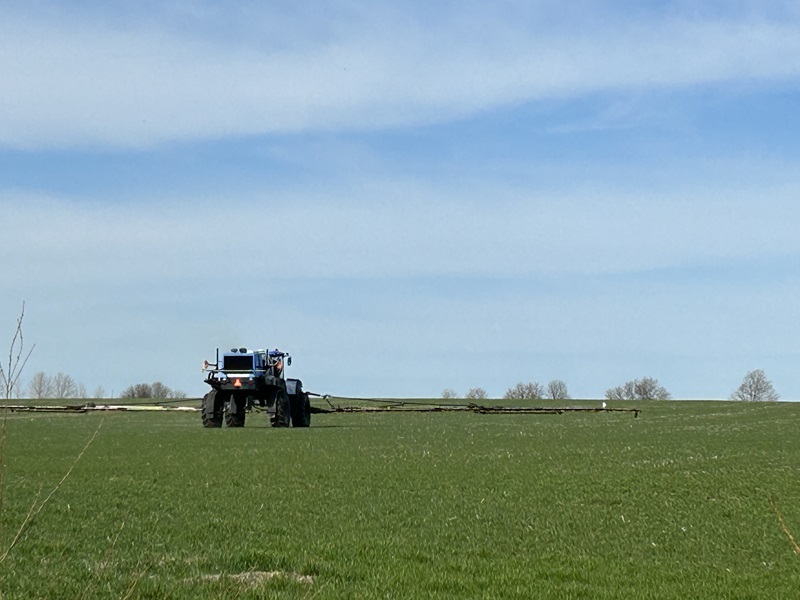
Stem elongation begins at GS 30. As temperatures increase, be on the lookout for leaf disease within the next few weeks. With dense canopies, stem elongation is an important time for T1 fungicide timing (if pressure and disease timing are sufficient), weed control and nitrogen applications. It is also the start of the optimum window for most plant growth regulator (PGR) applications. Read more about what PGRs are available on the market and optimum timings in this Ontario Grain Farmer article on PGRs and if a PGR should be used. Keep in mind that GS 32-39 is the recommended window for a second pass of N. Herbicide applications will also be approaching- always be sure to read the herbicide label of the product being applied, as timing can vary between products. Remember the Rule of Threes—day and night temperatures should be above 3 °C, three days before application, and three days after the application. When the crop is under temperature stress (from cool temperatures), the plant will metabolize the active ingredient slowly, increasing the risk of crop injury. Similarly, herbicides need to be applied when weeds are actively growing to be effective.
Fieldwork
If fieldwork is a must, be aware that spring tillage is not the same as fall tillage. There is a lot less forgiveness in spring tillage. Ensure that the situation is not worsened by working when the ground is unfit. The higher the clay content, the worse it will be. Working wet clay ground with primary deep tillage causes lots of smearing and reduces soil pores. Don’t smear and compact the soil, it will be paid for all year until the next winter freeze cycle helps to recondition the soil. Stay off wet soil and consider fixing up the planter and drill to accommodate stubble. If cover crops are utilized, anticipate higher residues from a good fall growing season, remember that not all cover crops are killed in winter, and plan accordingly.
Seed
Most farmers have their seed sitting in the shed, ready to plant. A few things to consider now: Is the seed size what you think it is? Be sure to go over the planting plan, list the hybrids and varieties, and match them up to fields based on agronomic considerations, such as herbicide programs or fertility zones.
It is a good idea to record everything so that when the rush hits and questions are being asked, others can step in and execute the planting plan. Make sure whoever is planting confirms what was planted and where. That way, the right herbicide and fungicide programs can be applied to the correct fields. Keeping good records limits the chance of spraying the wrong herbicide on the wrong crop.
Is the planter ready?
Before planting begins, make sure to spend the time needed to thoroughly inspect and fix the planter. Setting up the planter is a key step in assuring maximum yield through stand establishment.
Planter tires—right size and in good condition. Check the air pressure and adjust it to the correct pressure. Consult the user’s manual; the wrong tires or pressure level will affect the planted population. Then make sure the planter is level, start with the correct tongue height with your planting tractor, then check the planter frame for levelness.
Parallel linkage arms—check for free, smooth movement up and down. Also, check side-to-side movement. If too much movement occurs, this indicates that the bushings are worn and may need replacing. Also, make sure all linkage arms are straight and not bent.
Planter drive chains – check that the chains are not binding, and make sure all chains run smoothly and are not worn out. The drive chains need to run smoothly to help make the planter run correctly. Jumps and jerks will affect plantability and give seed skips in stands. Oil the chains and check the gears.
Gauge wheels – need to be free-moving and slide up and down snuggly to make sure the row unit runs at the set depth. When checking, pull the wheels up and check for sideways movement. If there is too much movement, tighten the arms.
Double disc openers – need to touch each other for a 1.5 to 2-inch distance along the disc tips to help create a V seed trench. If the discs don’t touch, they could be worn down or misaligned. Measure the diameter of the discs and make sure they fall within the equipment manufacturer’s guidelines. Typically, if they are smaller than 14.5 inches they need to be replaced. Proper V trench is essential for uniform seed placement in the trench and is the start to best seed-to-soil contact.
Seed tube guard—protects the seed tube. Worn tube guards need to be replaced before wear starts on the seed tube.
Seed tube—inspect all seed tubes to make sure they are not damaged. If they are worn or cracked, they can cause the seed to bounce, which causes uneven seed spacing in the trench. If they are worn, you will also need to replace the seed tube guards, as seed tube wear is an indication of worn-out guards.
Seed singulation—make sure they have been bench tested so the accuracy is known. Typical items that are checked are the condition of the knockoff brushes. The dimple wear on the backing plate and spring tension (on finger units). All help to reduce the number of double seeds being planted. Air planters need inspection of the brushes and plates for wear. Check that correct pressures can be maintained in the air system uniformly along all planter units. Check that each unit’s drive clutch aligns and doesn’t cause slips leading to seed skips in the field. Realign as required.
Closing wheels—need to be freely rolling. If the wheels are loose with too much play, the bushings will need to be replaced. Make sure the double disc opener lines up in the middle of the closing wheels.
Starter fertilizer discs and tubes – need to be operational and in the right position. This also needs to be checked when in the field, but make sure it is set up properly before heading to the field. If using dry starter fertilizer, make sure to have the fertilizer band far enough away from the seed as to prevent fertilizer burn on the seed. Most growers use 2×2-inch band from the seed, although it depends on the source of fertilizer and rate. Fertilizer burn can be confirmed if seed in the field looks dead but has a bit of whitish crystals on it. It is not poor seed; it is fertilizer that was placed too close to the seed. This may have occurred due to loose coulters that moved while planting, or something like rocks may have hit them loose. If using liquid fertilizer, check the pump and drive chains.
Be sure to do a test run and check that the double disc opener is in the middle of the closing wheels and not off to one side. If they are, realign them or check why they are not aligned. Is something bent or broken? Closing wheels need to be centred over the double disc opener so that the seed has uniform soil pressure on both sides equally.
When in the field, check the down force by examining the gauge wheels adjust as required for the conditions. Too much pressure will prevent the gauge wheels from rotating, cause excess wear and tear on the equipment, and put too much pressure on the seed trench, leading to sidewall compaction problems. If the gauge wheels run too freely then there is not enough down force to position the row unit, and the unit will float causing uneven planting depths. Gauge wheels should be snug, not too tight or loose.
Uniform seed placement is the goal of a finely tuned planter. To make sure the planter is operating properly do a few field checks and measure seed placement in the row. Is seed at the right depth? Is there proper seed-to-soil contact? Is there enough soil moisture at this depth? Is the fertilizer placement correct? If not, make the adjustments for the conditions for maximum crop potential. If the planter is bouncing in the field, slow down as all the excessive movement and vibration not only places the seed at variable depths but can also cause seeds to be dislodged from the singulator, creating skips in the field.
GrainTALK webinar: Least cost crop production
Join Marty Vermey, senior agronomist and Sankalp Sharma, senior economist with Grain Farmers of Ontario, in this GrainTalk webinar on least-cost crop production, concentrating on finding efficiencies and homing in on areas to focus on both agronomic and economic aspects of Ontario grain farming operations. This webinar has been approved for CCA CEUs.
April 17, 2025
This is the first field observation of the year after what seemed like a never-ending winter. At the start of April, we have certainly seen some swings in weather, from six inches of snow in some regions to plenty of rain. Finally, with some beautiful weather on the horizon, Ontario certainly has experienced it all. But, with these weather events experienced, there has been some impact on the winter wheat crop.
Winter wheat
Due to the excessive snow in some regions, snow mould has been a concern. Snow mould occurs when the ground does not freeze enough before snow accumulation. The snow insulates and allows pathogens to survive and grow on plants throughout the winter. Once the snow has disappeared, damp, cool conditions allow for further pathogen growth and continue damaging the plants. More information on snow mould, how to identify it, and how to assess plants for yield loss can be found here. If a high incidence of snow mould has occurred, aim to plant in the optimum planting date in future years. The optimum planting date map can be found at GoCrops.ca.
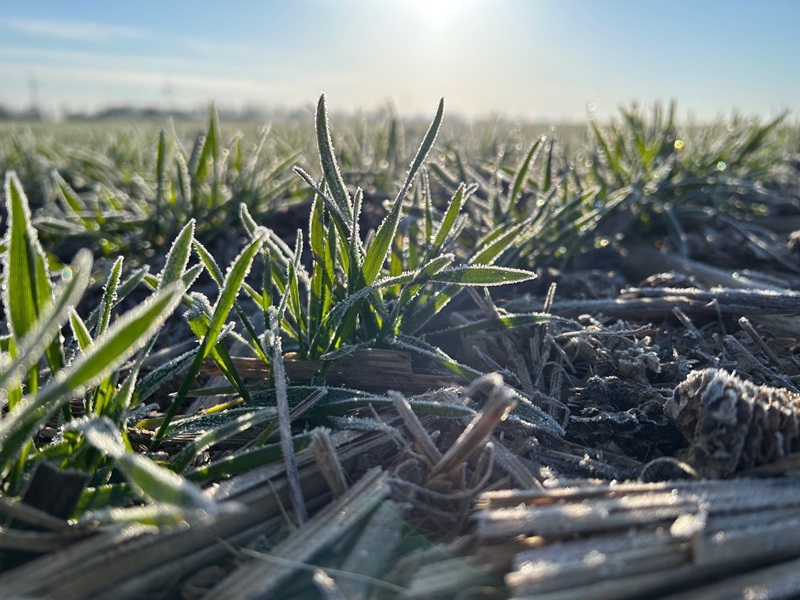
frosty mornings. Photo supplied by Marty Vermey
Some areas have experienced ice encasement of wheat due to water ponding and then freezing. When this occurs, the ice traps carbon dioxide and suffocates the plant by inhibiting respiration. Some plants may be dead, and some may be weakened. Be sure to scout and assess for plant stand. There are four main steps when assessing spring plant stands. Read more in the A Visual Guide to Winter Wheat Staging, pages 18 and 19.
When scouting, purple tissue may be identified—stress from the past week of cold temperatures has set the plants back a bit. When the soil is cool and wet, phosphorus uptake slows. Also, yellowing on the leaves at the bottom of the plant might be noted due to wet roots from saturated soils.
As fields green up and begin actively growing, keep an eye on growth stages as timing for a T1 fungicide, herbicide applications and/or the start of the optimum window for most plant growth regulator applications will be soon approaching at GS 30 (stem elongation). Some areas have begun the first pass of nitrogen on winter wheat in the deep southwest.













